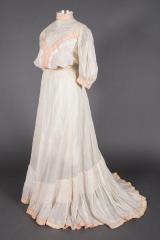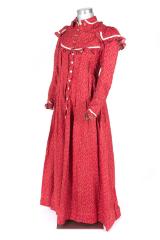Comments and Tags
Be the first to comment on this item!
Clothing and Accessories
Women's Clothing ➔ Dress
Identifier:
121272Description:
This batiste lingerie day dress features a lace neckline and embroidered designs down the front of the dress. There are decorative crocheted buttons on the front of the skirt and on the sleeves. Pintucks can be seen on the shoulders, sleeves, and at the waist of the skirt. There are lace inserts on the bodice, sleeves, and skirt. Hook and eye closures can be seen at the center back of the bodice. Features that indicate this dress is from the early 1900s are the monobosom, the lace inserts, the three-quarter length sleeves, and the narrow waist.he lingerie dress was a style of day dress that appeared at the end of the Victorian Era in the late 1890s and remained popular through the Edwardian Era until around 1915. It is typically a white dress made of lightweight cotton such as muslin or batiste that incorporates lace inserts, ruffles, and embroidery. This style of dress was popular among women of both lower and upper classes. Although white clothing used to symbolize wealth, the lingerie dress was worn by women of all social statuses because it was easy to create thanks to sewing machines, readily available patterns, and machine-constructed laces. The color white was used because of its ease to wash and also because this style of dress was created to mimic women’s undergarments, using the same color, fabrics, and decor. It was commonly worn for afternoon functions during warmer weather and was also referred to as a tea dress or a lingerie frock.
Date:
circa 1909 – 1915Materials:
Batiste, lace, lace insertsCurrent Location Status:
In StorageCollection Tier:
Tier 2Source:
Gift Of Estate Of Henry IdemaRelated Entity:
Estate of Henry Idema (donor)Henry Idema of Grand Rapids, Michigan was born in 1856 to Henry Idema and Frances Vanderploeg. He was a banker and was Chairman of the Board of Old Kent Bank since 1908. He was also the Vice President of the Michigan Trust Company. On February 3rd, 1880 he married Annie Doornink and together they had three children: Chester F. Idema, Walter D. Idema, and Edward H. Idema. He passed away on January 5th,1951 and is buried at Woodlawn Cemetary in Grand Rapids, Michigan.


